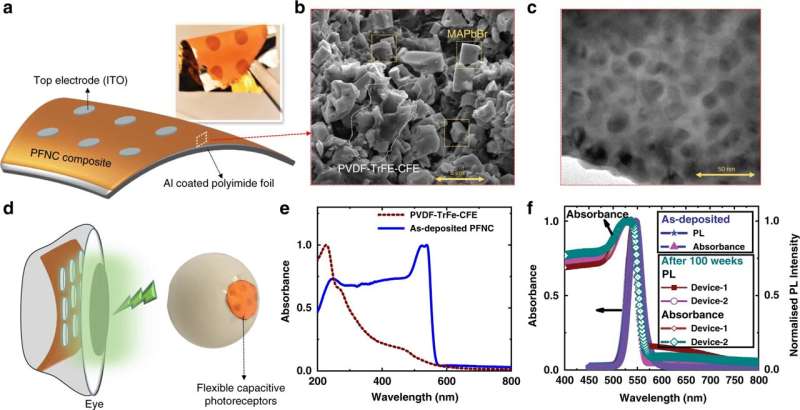
An artificial electronic retina that can “see” in a similar way to the human vision system and can recognize handwritten digits has been built by KAUST researchers as they seek to develop better options for computer vision applications.
Mani Teja Vijjapu, an electrical engineering Ph.D. student, Khaled Nabil Salama and coworkers have designed and fabricated an array of photoreceptors that detect the intensity of visible light via a change in electrical capacitance, mimicking the behavior of the eye’s rod retina cells. When the array was connected to an electronic CMOS-sensing circuit and a spiking neural network (a single-layer network with 100 output neurons), it was able to recognize handwritten numbers with an accuracy of around 70 percent.
“The ultimate goal of our research in this area is to develop efficient neuromorphic vision sensors to build efficient cameras for computer vision applications,” explained Salama. “Existing systems use photodetectors that require power for their operation and thus consume a lot of energy, even on standby. In contrast, our proposed photoreceptors are capacitive devices that don’t consume static power for their operation.”
The photoreceptor array is made by sandwiching a material with suitable optical and dielectric properties between a bottom aluminum electrode and a patterned top electrode of indium tin oxide to form a pixelated array of miniature light-sensitive metal-insulator-metal capacitors. The array is made on a thin substrate of polyimide so that it is flexible and can be curved as desired, including a hemispherical shape mimicking the human eye.
In selecting materials for their photoreceptor, the KAUST team used a hybrid material of perovskite (methylammonium lead bromide (MAPbBr3)) nanocrystals embedded in terpolymer polyvinylidene fluoride trifluoroethylene-chlorofluoroethylene (PVDF-TrFE-CEF). Already of great interest in solar cell research, MAPbBr3 is a strong absorber of visible light, while PVDF-TrFE-CEF has a high dielectric constant. “We chose hybrid perovskites because of their exceptional photoelectronic properties, such as excellent light absorption, long carrier lifetime and high carrier mobility,” explained Vijjapu.
Tests with a 4×4 array and LED illumination of different visible colors indicate that the optical response of the array mimics the response of the human eye with a maximum sensitivity to green light. Importantly, the photoreceptors are also found to be highly stable, with no change in response even after being stored for 129 weeks in ambient conditions.
Future plans for the team include building larger arrays of photoreceptors, optimizing the interface circuit design and employing a multilayered neural network to improve the accuracy of the recognition functionality.
Development of an artificial vision device capable of mimicking human optical illusions
Mani Teja Vijjapu et al, A flexible capacitive photoreceptor for the biomimetic retina, Light: Science & Applications (2022). DOI: 10.1038/s41377-021-00686-4
Citation:
Perovskites used to make efficient artificial retina (2022, February 23)
retrieved 23 February 2022
from https://techxplore.com/news/2022-02-perovskites-efficient-artificial-retina.html
This document is subject to copyright. Apart from any fair dealing for the purpose of private study or research, no
part may be reproduced without the written permission. The content is provided for information purposes only.
Stay connected with us on social media platform for instant update click here to join our Twitter, & Facebook
We are now on Telegram. Click here to join our channel (@TechiUpdate) and stay updated with the latest Technology headlines.
For all the latest Technology News Click Here
For the latest news and updates, follow us on Google News.
